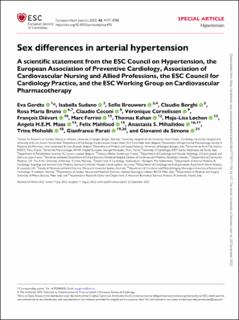| dc.contributor.author | Gerdts, Eva | |
| dc.contributor.author | Sudano, Isabella | |
| dc.contributor.author | Brouwers, Sofie | |
| dc.contributor.author | Borghi, Claudio | |
| dc.contributor.author | Bruno, RM | |
| dc.contributor.author | Ceconi, Claudio | |
| dc.contributor.author | Cornelissen, Veronique | |
| dc.contributor.author | Dievart, Francois | |
| dc.contributor.author | Ferrini, Marc | |
| dc.contributor.author | Kahan, Thomas | |
| dc.contributor.author | Løchen, Maja-Lisa | |
| dc.contributor.author | Maas, Angela H.E.M. | |
| dc.contributor.author | Mahfoud, Felix | |
| dc.contributor.author | Mihailidou, Anastasia Susie | |
| dc.contributor.author | Moholdt, Trine | |
| dc.contributor.author | Parati, Gianfranco | |
| dc.contributor.author | de Simone, Giovanni | |
| dc.date.accessioned | 2022-12-30T14:24:51Z | |
| dc.date.available | 2022-12-30T14:24:51Z | |
| dc.date.created | 2022-11-18T19:14:29Z | |
| dc.date.issued | 2022 | |
| dc.identifier.issn | 0195-668X | |
| dc.identifier.uri | https://hdl.handle.net/11250/3040121 | |
| dc.description.abstract | There is strong evidence that sex chromosomes and sex hormones influence blood pressure (BP) regulation, distribution of cardiovascular (CV) risk factors and co-morbidities differentially in females and males with essential arterial hypertension. The risk for CV disease increases at a lower BP level in females than in males, suggesting that sex-specific thresholds for diagnosis of hypertension may be reasonable. However, due to paucity of data, in particularly from specifically designed clinical trials, it is not yet known whether hypertension should be differently managed in females and males, including treatment goals and choice and dosages of antihypertensive drugs. Accordingly, this consensus document was conceived to provide a comprehensive overview of current knowledge on sex differences in essential hypertension including BP development over the life course, development of hypertension, pathophysiologic mechanisms regulating BP, interaction of BP with CV risk factors and co-morbidities, hypertension-mediated organ damage in the heart and the arteries, impact on incident CV disease, and differences in the effect of antihypertensive treatment. The consensus document also highlights areas where focused research is needed to advance sex-specific prevention and management of hypertension. | en_US |
| dc.language.iso | eng | en_US |
| dc.publisher | Oxford University Press | en_US |
| dc.rights | Navngivelse-Ikkekommersiell 4.0 Internasjonal | * |
| dc.rights.uri | http://creativecommons.org/licenses/by-nc/4.0/deed.no | * |
| dc.title | Sex differences in arterial hypertension | en_US |
| dc.type | Journal article | en_US |
| dc.type | Peer reviewed | en_US |
| dc.description.version | publishedVersion | en_US |
| dc.rights.holder | Copyright 2022 The Author(s) | en_US |
| cristin.ispublished | true | |
| cristin.fulltext | original | |
| cristin.qualitycode | 2 | |
| dc.identifier.doi | 10.1093/eurheartj/ehac470 | |
| dc.identifier.cristin | 2076641 | |
| dc.source.journal | European Heart Journal | en_US |
| dc.source.pagenumber | 4777-4788 | en_US |
| dc.identifier.citation | European Heart Journal. 2022, 43 (46), 4777-4788. | en_US |
| dc.source.volume | 43 | en_US |
| dc.source.issue | 46 | en_US |

